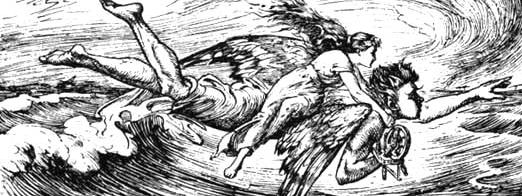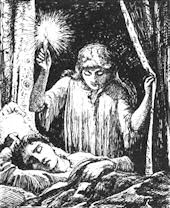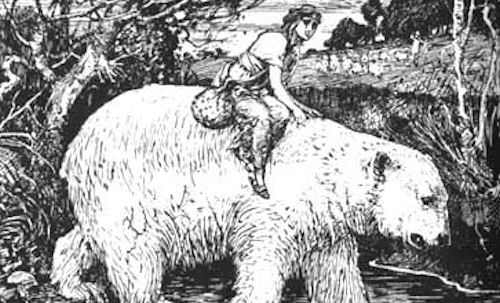




As mentioned earlier, the vulnerability of the family is the starting point of both Norwegian Fairy Tale and very English Novel.
Into this setting comes a male admirer of one of the daughters of the family: in both cases he chooses the father's favourite. We are told this explicitly in the Novel, while the Fairy Tale shows that it is the father alone who consults with the daughter about the attractive offer from the white bear. How often in Fairy Tale does a father take time to reason with his daughter?
Both stories are told from the point of view of the chosen girl, but in each case the reader/listener knows what is happening in the heart of the male admirer, although neither girl understands all that we know. These are precisely the details which catch and hold our interest, sometimes shamelessly, and we find ourselves completely engaged in the story.
* * * * *
It's not only in Fairy Tale, but no sooner is a character warned against doing something, but he or she can be counted upon to perform the proscribed action within the shortest possible delay. The daughter in the Fairy Tale is warned specifically that her mother threatens their happiness. And so, quite naturally, quite predictably, the girl permits the mother to give her the candle which will bring disaster upon all concerned.
In the Novel, the indescribably stupid and vicious Mrs. Bennet is driven to destroy the prospects of her eldest and loveliest daughter Jane. Even though the injury is to the sister rather than heroine, the characters and plot in Pride and Prejudice are so tightly woven into a single fabric that the effect is the same as in the Fairy Tale.
The Fairy Tale's stepmother/witch has earmarked the Prince for her ugly daughter; Lady Catherine de Bourgh, Mr. Darcy's aunt and a bona fide though introvertibly human witch, has done the same on behalf of her rather pitiful and unloved only child.
Then there is the fundamental misunderstanding that the reader understands, or at least suspects correctly, but is unknown to the heroine of the story — until she takes the action that causes unforgivable harm to the admirer, and irreparable damage to their relationship. At which time she realizes that the admirer is the one man who could make her happy. In the Fairy Tale it is the mother who precipitates the betrayal; in a charming twist the Novel has the handsome but reptilian Mr. Wickham as instigator in place of the mother.
Is it possible that in this section we are very close to the reasons the Novel has endured for two hundred years, and the Fairy Tale for two thousand and likely more? If you do not obey me, you'll spoil our happiness, says the white bear, seemingly unaware that the girl is not happy, never was, not really, no matter how much she has been surrounded with beautiful objects of silver and gold.
The story is told from the point of view of the girl, but there is another vantage point, equally important. Neither the prince/white bear nor Mr. Darcy consider it necessary to confide in the girl precisely what are their expectations of her — until she has proven herself unworthy of their regard, and the relationship is seemingly at an end. The prince/white bear obviously feels that lavishing gold and silver on the girl and her family is enough to ensure her gratitude and happiness — and Mr. Darcy just as obviously believes that his ability to do the same absolves him from the formality of ingratiating himself with Elizabeth before asking her to marry him.
And both girls discover that they have been deceived in their hearts, when they are enabled at last to see their admirer as he really is, in a new and different light, after it is too late.
The remainder of Fairy Tale and Novel follows a similar course, during which the girl sets forth on the series of journeys that will lead her to end the estrangement from the wronged hero. No one actually tells Elizabeth Bennet, You must be the one who is meant to have the prince. Climb on my back and I'll cary you there. No one actually needs to tell her. The result is the same.
The delightful part of this exercise in concordance between primitive Fairy Tale and 19th century English Novel is the realization that East of the Sun and West of the Moon would be a perfectly acceptable choice for my Sandsifter Five series of artistic selections, if we judge by the list of common characteristics set out in the Definitions page of this website.
Which is more than can be said for the accompanying Myth — which is too busy playing subversive jokes on the reader to be concerned with character or even sense.
* * * * *
We'll see what Myth has to teach us in the following section, Myth and Pride and Prejudice. The choice is inescapable:—Lucius Apuleius's Amor and Psyche, a Myth that so resembles East of the Sun and West of the Moon it seems inescapable one must have evolved from, or been incorporated into, the other.
After all, how many stories follow an arc where the heroine is forbidden to look into the face of the man who sleeps in the bed beside her — which she does, of course, as a result of prompting by a close family member? Where the disobedience is revealed by the girl allowing a drop of hot wax from a candle (Fairy Tale) and hot oil from a lamp (Myth) to fall onto the sleeping male? And where the girl then follows him to the ends of the earth in order to repair the damage she has done to their existence as a couple?
Lucius Apuleius, Amor and Psyche (relying on the website
http://www.euphoniousmonks.com/amor.htm)
________________________